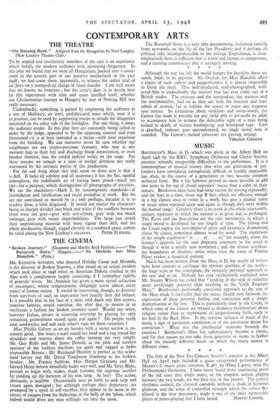MUSIC
BEETHOVEN'S Mass in D, which was given at the Albert Hall on April 14th by the B.B.C. Symphony Orchestra and Choral Society, presents virtually insuperable difficulties to the performers. It is a commonplace of musical history that what one generation of per- formers have considered outrageously difficult or frankly impossible has often, in the course of a generation or two, become common technical form. But it has hitherto proved no more possible to add two notes to the top of choral sopranos' voices than a cubit to their stature. Beethoven must have had some reason for writing repeatedly, and for bars at a time, those top B flats which are effective enough in a big climax once or twice in a work, but give a painful sense of strain when repeated again and again as though they were within the normal range. Certainly there is no work in the whole nineteenth- century repertory in which the tension is so great and so prolonged. The Kyrie and the Benedictus are the only movements in which a single mood is developed for any length of time. The Gloria and the Credo exploit the extremities of pitch and dynamics, dramatising clause by clause, sometimes almost word by word. The repetitions of the simple copulative " et . . . et . . . et," for example, whets the listener's appetite for the next dogmatic statement in the creed as though it were a wholly new revelation ; and the drama overflows the boundaries of dramatic sense when even the name of Pontius Pilate evokes a theatrical gesture.
Much has been written about the Mass in D, but nearly all writers have been content to catalogue the obvious qualities of the work— the huge scale of the conception, the intensely personal approach to the text and so on. Nobody has ever satisfactorily explained what Mr. Steuart Wilson has called that " rending of the veils of reticence more terrifyingly personal than anything in the Verdi Requiem Mass." Beethoven's profoundly emotional approach to the text of the Mass made it inevitable that the music should vary between the expression of deep personal feeling and conviction and a simple dramatisation of the text. This is particularly clear in the Credo, in which some of the clauses are treated as dramatic exclamations about religion rather than as expressions of unquestioning faith, such as we find in the Bach Mass. Is the extreme violence of much of the music a sign of passionate conviction or of the passionate desire for conviction ? What was the intellectual structure beneath the emotion ? Beethoven's Mass has unfortunately become a classic, and for that reason no one asks these questions or seems to bother about the entirely different levels on which the music moves at different times.
* *
The fifth of the New Era Concert Society's concerts at the Albert Hall on April 19th included a quite exceptional performance of Mozart's C major piano concerto, K.467, by Dinu Lipatti, with the Philharmonia Orchestra. I have never heard more convincing proof of the old story that single notes, or the simplest unison playing between the two hands, are the final test of the pianist. The perfect rhythmic control, the classical cantabile without a shade of fictitious glamour, and the sense of controlled strength which the soloist dis- played in the slow movement, made it one of the most memorable pieces of piano-playing that I have heard. MARTIN COOPER.


































 Previous page
Previous page